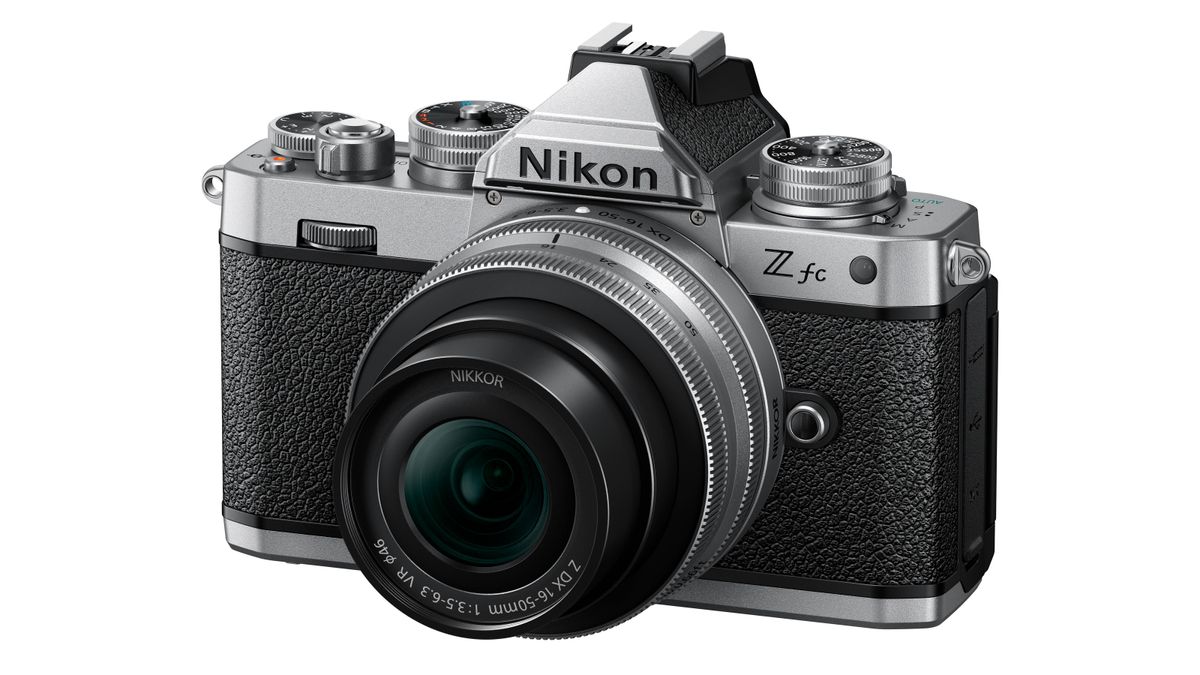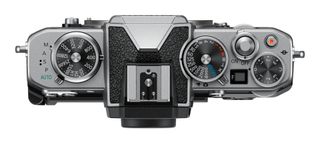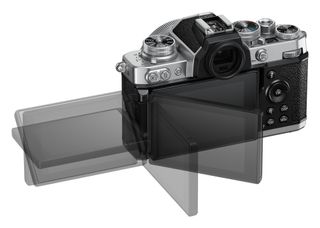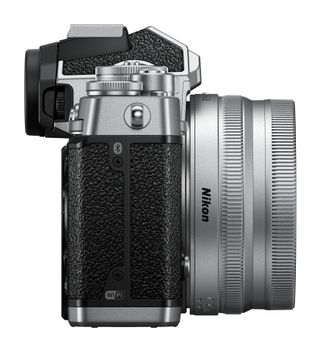Nikon embraces retro chic with its new Nikon Z fc mirrorless camera
Nikon's latest mirrorless goes back to the future with mechanical dials and heritage design features

The Nikon Z fc is officially announced! It's Nikon's new retro-styled APS-C format mirrorless camera, a stablemate to the Nikon Z50 that's now been revealed at last after weeks of rumors.
• Nikon Z50 review
• Best Nikon cameras
• Best mirrorless cameras
• Best vlogging cameras
• Best cameras: how to choose
Despite technical parity with the Nikon Z50, at first glance you’d be forgiven for thinking that the new Nikon Z fc might have been retrieved from a drawer at the back of a pre-loved camera retailer. Its silver and black body and myriad of dials looks every bit a classic camera of yesteryear. And indeed, Nikon freely admits that its latest Z-series camera has been inspired by the iconic Nikon FM2 SLR film camera released in the early Eighties, with other design details including the adoption of a circular eyepiece for the electronic viewfinder (EVF), and an inscribed Nikon logo.
It’s not the first time that Nikon has been inspired by its heritage models, wrapping a modern digital camera with a retro body sporting mechanical-style controls. The Nikon Df DSLR was launched back in 2013, but that was a top-spec full-frame camera with a price tag to match. With the Z fc Nikon is aiming squarely at the enthusiast end of the market, with an APS-C size sensor, omitting in-body image stabilization, and with specs far closer to the Z50 model than the Nikon Z6 II or Nikon Z7 II.
Indeed, reading the tech specs alone you’d be hard-pressed to find many differences between this and the Z50. Under the bonnet of both cameras is an Expeed 6 processor. The APS-C sensor has the same 20.9MP resolution, with 209 hybrid autofocus points embedded to cover 90 per cent of the sensor area. The ISO range is an identical 100-51,200, expandable up to ISO204,800. Hi-speed continuous shooting also maxes out at 11fps. The electronic viewfinder is the same 0.39in XGA OLED model with 2360k-dot resolution showing 100% of the image at 1.02x magnification, while the rear-LCD monitor appears to be an identical 3in 3:2 format 1040k-dot touchscreen design.
• Read more: Nikon Z fc vs Nikon Z50

Manual controls
But on the outside things are very different. Aside from the achingly cool retro design chic, the multitude of dials enables shutter speed, ISO and exposure compensation to be set directly, which is far faster than scrolling through the values with combinations of button-presses and rotating the command dial. The aperture, which would traditionally be set on the lens on mechanical-era cameras, is displayed in a discreet panel atop the camera, showing you all the vital exposure settings at a glance.
An exposure mode selector had just five options: Manual, Shutter Priority, Aperture Priority, Program and Auto, though Nikon is keen to point out that it sees this camera as appealing to to the more technically minded user. While the shutter speed dial enables settings between 1/4000 sec and 4 sec in full-stop steps, a1/3 step option on the dial allows in between settings, all the way up to 1/30 sec. Additional Bulb and Time modes allow for even longer exposures.
Get the Digital Camera World Newsletter
The best camera deals, reviews, product advice, and unmissable photography news, direct to your inbox!
For the first time in a Nikon Z series camera, exposure compensation can be applied in Auto mode, enabling the brightness of images to be increased or to shoot silhouettes, for example. There are no less than 20 Creative Picture Control options to fine-tune the look of images by selecting different parameters such as hue, toning and saturation and so on.
Borrowed from the feature set of the Z7 II and Z6 II, the Nikon Z fc supports Eye-Detection AF and Animal-Detection AF with the shooting of stills and video. The wide-area AF (L) AF-area mode ensuring the clear capture of eyes and faces by limiting the focusing area, continuously focusing on the eyes of the intended subject when there are several people in the frame, or the tracking of eyes of a moving pets.

That flippin' screen
And while the rear LCD screen in the Z50 was able to flip down for selfies, this is the first Z-series camera to sport a true vari-angle display that flips out to the side panel and can rotate 180º to be viewed from either the rear or the front of the camera and for high- and low-angle shooting.
Importantly, this means the screen can be viewed when the camera is mounted on a tripod; this was obscured by the tripod column on the Z50. When the monitor is rotated to the front, the camera automatically switches to self-portrait mode, enabling smooth selfie shooting with touch operation. The screen can also be neatly folded into a recess on the back of the body for added protection when stowed away.
Another improvement over the Z50 is that the camera can be operated while it’s being charged – which is handy for power-hungry video shoots or setting the camera for time-lapses and the like.
One aspect found on the Z50 that appears to be absent on the Z fc, however, is a pop-up flash. While these are underpowered for serious photography, they’re undeniably handy for when a blip of light is required or when controlling external Speedlights using Nikon’s Creative Lighting System.

SE lenses
Alongside the camera itself, Nikon has launched a pair of lenses with metallic detailing to complement the retro styling. The Nikkor Z DX 16-50mm f/3.5-6.3 VR Silver Edition is essentially the Z50’s existing kit lens with a cosmetic makeover, featuring a silver exterior design to match the Nikon Z fc. The lens is compact and lightweight, with a total length of 32mm and weighing in at just 135g, and offers an 24-75mm equivalent zoom range when compared to full-frame bodies.
The Nikkor Z 28mm f/2.8 SE is an entirely new prime designed specifically to match the camera body, which gives a 42mm field of view once the effective focal length is taken into account. Nikon says that this compact and lightweight lens is ideal for portraits and still-life photography, providing the smooth bokeh that is unique to prime lenses.

Release date and pricing
The camera goes on sale 28 July 2021, with a pretty attractive launch price, coming in at $956.95 / £899 / AU$$1,499.95 body only. Plus there are various kit options that include the SE lenses as well as a vlogger kit:
• Nikon Z fc + Z 28mm f/2.8 SE kit: $1,196.95 / £1,129 / AU$1,899.95
• Nikon Z fc + Z DX 16-50mm f/3.5-6.3 kit: $1,096.95 / £1,039 / $1,699.95
In territories including Australia and Japan you can get the Z fc 16-50mm kit in a choice of colors including Amber Brown, White, Natural Gray, Sand Beige, Coral Pink and Mint Green!
Kits and options may vary by territory:
• Nikon Z fc + Z DX 16-50mm f/3.5-6.3 + Z DX 50-250mm f/4.5-6.3 kit (UK/Europe): £1,249 / AU$$1,999.95
• Nikon Z fc Vlogger kit (UK/Europe): £1,189
Pre-order the Nikon Z fc at Adorama (US)
Pre-order the Nikon Z fc at B&H (US)
Pre-order the Nikon Z fc at Park Cameras (UK)
Pre-order the Nikon Z fc at Wex (UK)
Pre-order the Nikon Z fc at Ted's Camera (AU)
Read more:
• Nikon Z50 review
• Best Nikon cameras
• Best mirrorless cameras
• Best vlogging cameras
• Best cameras: how to choose
• Technical issues with Nikon Z6 and Z7 stabilization

Prior to joining digitalcameraworld.com as News Editor, Adam was the editor of N-Photo: The Nikon Magazine for seven years, and as such is one of Digital Camera World's leading experts when it comes to all things Nikon-related.
Whether it’s reviews and hands-on tests of the latest Nikon cameras and lenses, sharing his skills using filters, tripods, lighting, L brackets and other photography equipment, or trading tips and techniques on shooting landscapes, wildlife and almost any genre of photography, Adam is always on hand to provide his insights.
Prior to his tenure on N-Photo, Adam was also a veteran of publications such as PhotoPlus: The Canon Magazine, so his wealth of photographic knowledge isn’t solely limited to the Big N.